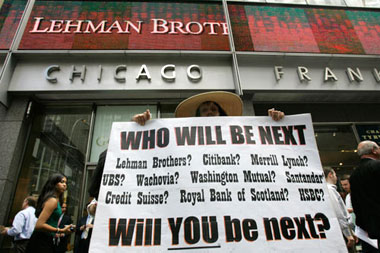全球金融
Where's the next Lehman?
下一个雷曼兄弟在哪儿?
Five years after the maelstrom of September 2008, global finance is safer. But still not safe enough
五年前国际金融历经了2008年9月金融危机的冲击,现在更加稳健了,但仍非万无一失。
The bankruptcy of Lehman Brothers, an American investment bank, in 2008 turned a nasty credit crunch into the worst financial crisis in 80 years.
雷曼兄弟是一家美国投资银行,2008年,该行的破产将一场严重的信贷紧缩变成了80年来最严重的经济危机。
Massive bail-outs from governments and central banks staved off a second Depression, but failed to prevent a deep recession from which many rich economies have yet fully to recover.
政府和央行纷纷大规模救市,避免了经济二次萧条。然而,许多发达经济体尚未完全恢复经济发展活力,救市未能阻止一场严重衰退的降临。

Five years after that calamity, two big questions need to be answered. Is global finance safer? And are more crises on the horizon?
继金融危机发生后,时隔五年,摆在我们面前的两个重要问题是:国际金融是否更加稳健了?是否会有更多危机即将来临?
The quick answers are yes, and yes.
简单来说,的确如此。
Global finance looks less vulnerable because reforms to the financial industry have made it more resilient, and because America, the country at the heart of the Lehman mess, has got rid of much of the excess debt and righted many of the imbalances in its economy.
由于金融业改革,国际金融更加能够抵御冲击。并且由于处于金融危机中心的美国,清理了大量超额债务并纠正了经济运行中诸多不平衡因素,国际金融看起来不再那么不堪一击了。
Today's danger zones are elsewhere. They are unlikely to spawn a collapse on the scale of 2008.
如今,危险的区域在别的地方,尽管这些国家不太可能在2008年的大规模金融危机中破产。
But they could produce enough turmoil to hit growth hard.
但是,它们却制造了许多足以阻碍经济增长的动荡。
The disaster of September 2008 had many causes, as the first of our series of “schools briefs” makes clear.
正如本报“学派简介”系列文章第一期中所阐明的那样,2008年9月金融危机的成因有很多。
But, put crudely, Lehman's demise spawned catastrophe because it combined three separate vulnerabilities.
但是,笼统地讲,雷曼兄弟破产之所以引发了一场大灾难是因为它包含了三种不同的金融体系缺陷。
The underlying one was a surge in debt, particularly in the financial sector, brought on by a housing bubble.
根本的缺陷是,债务激增,尤其是在金融部门,这是由房地产泡沫所致。
The ensuing bust was made more dangerous because of the second weakness: the complex interconnections of securitised finance meant that no one understood what assets were worth or who owed what.
由于金融体系的第二个缺陷,即:证券化融资的复杂联系意味着没有人理解什么资产有价值及谁拥有什么资产,因此,随后发生的萧条更加危险。
Lehman's failure added a third devastating dimension: confusion about whether governments could, or would, step in as finance failed.
雷曼兄弟的破产增加了第三种破坏因素,即:对于当金融业遭遇危机时,政府是否可以及会不会插手干预的疑虑。
A rule of thumb for spotting future disaster is how far those weaknesses—a debt surge, ill-understood interconnections and uncertainty about a safety net—are repeated.
对于发现未来金融危机的经验论观点就是,这些缺陷(债务激增,误解联系,安全金融网络的不确定因素)要重复出现多久。
The overhaul of financial regulation since 2008 has made most progress on the first two.
自2008年来,总体的金融监管工作已经在克服前两个缺陷上取得了进展。
Under the new Basel capital standards banks are being compelled to hold more, and better, capital relative to their assets; the biggest “systemic” banks even more than others.
在新巴塞尔资本标准要求下,银行被迫持有更多更好的和资产相关的资本;比起其他国家,拥有甚至更多的最大系统性银行。
Another strand of reforms, such as pushing derivatives trading onto clearing-houses, has tried to improve transparency.
另一改革链已成功提高了透明度,比如:将衍生品交易转移到结算所。
Least progress has been made on what to do when big banks fail—though new efforts to write global rules that would force banks to issue bonds that can be “bailed in” in the event of failure is a promising step.
尽管制定国际规则的新一轮努力是充满希望的,该国际规则将迫使银行在经营失败时发放保释证券,但就大银行经营失败时所应当采取的措施而言,几乎未取得进展。
American finance has become safer.
美国的金融体系已经变的更加稳健了。
The country's big banks have raised more capital and written off more dud assets than most others.
比起其他国家的银行,该国的大银行已筹集了更多资本并注销了更多不良资产。
At around 13%, their risk-weighted capital ratio is far above the new global norms and some 60% higher than before the crisis.
美国这些大银行的风险加权资本比例大约为13%,远高于国际规范,并且比危机之前高约60%。
American property prices have adjusted and households have cut their debts.
美国的房地产价格已得以调整,并且美国家庭的债务得以削减。
Government debt has risen, but most of that rise is the sensible mirror-image of efforts by households to reduce theirs.
政府债务高涨,其大部分涨幅清晰地折射出了美国家庭在努力地削减自身债务。
Now that the economy is recovering, the budget deficit is tumbling.
由于经济逐渐回暖,预算赤字也巨幅下滑。



